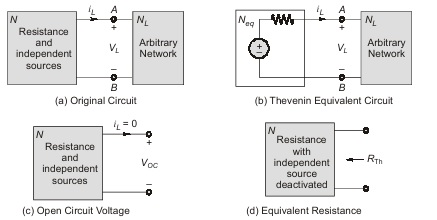THEVENINS THEOREM
To develop Thevenin’s theorem, consider figure consisting of two two-terminal networks, N and NL, joined at A and B. ‘N’ consist of only resistors and independent sources, whereas NL contains arbitrary even non-linear elements. Suppose NL undergoes various changes while N remains unchanged.

To simplify repeated calculations, N is replaced by a simple circuit called its Thevenin equivalent, as shown in fig. (b). The Thevenin’s equivalent consists of a single voltage source Voc in series with a single resistance RTh.
Thevenin’s theorem states that a linear two-terminal circuit can be replaced by an equivalent circuit consisting of a voltage source Vth in series with a resistor Rth, where Vth is the open-circuit voltage at the terminals and Rth is the input or equivalent resistance at the terminals when the independent sources are turned off.

